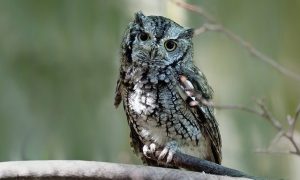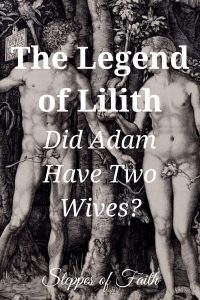
“There, too, Lilith shall repose and find a place to rest.” Isaiah 34:14
Isaiah 34:14 mysteriously mentions a woman named Lilith. It is the only place in the Bible where you will find any mention of her.
“Wildcats shall meet with hyenas, goat-demons shall call to each other; there, too, Lilith shall repose and find a place to rest.” (NRSV)
Other modern Bible versions, such as the Amplified Bible and the Message Bibles, also use the name Lilith.
More traditional Bibles, such as the New King James, NIV, NAS, and many others, translate Isaiah 34:14 differently. They do not use Lilith or its variant lilit. Instead, they use references to nocturnal creatures, such as screech owls, or simply use the term “night creature” or “night monster.”
“The wild beasts of the desert shall also meet with the jackals, and the wild goat shall bleat to its companion; also, the night creature shall rest there and find for herself a place of rest.” (NKJ)
The original Hebrew word for “the night” is Lilith. Different Bible translations come from different interpretations. So, when we read certain versions, the original Hebrew translation is sometimes lost or skewed, rendering Lilith as a night creature or a demon.
Sadly, the differences in translation blur the meaning of Isaiah 34:14. The prophet is not speaking of a creature or even a woman but of the future destruction of Edom (modern-day Jordan). Using both real and imaginary creatures, Isaiah describes the darkness and terror (“the night”) that Edom will experience when the Babylonians eventually lay waste to their land.
The Babylonians later fulfilled the prophecy in the 6th century BC when they conquered and destroyed Edom following its rebellion against both Judah and Babylon (2 Kg 24:1-7).

Differing Beliefs
Why do some translations portray Lilith as a night creature or demon? Where did this belief originate?
In ancient Babylonian demonology, there were two demons—a male named Lilu and a female named Lilitu, or Lilith. Lilu had no defined function, but Lilith was widely known around the world. Different cultures gave her different names, but she was generally known as a dark spirit, roaming the earth during the night. Her general goal was to harm, if not kill, others and produce more demons.
Eventually, Lilith entered Israelite culture, making her way into the Jewish Talmud and Kabbalah (Jewish mysticism) texts. Both texts describe Lilith as someone who harms mothers as they give birth and strangles their babies.
The belief was so strong that Jewish families commonly placed amulets on every wall in the mother’s room while she was in labor. They inscribed each amulet with the names and physical forms of the heavenly angels charged to watch Lilith and keep her away. Hanging amulets in such a way became a widespread practice up to the eighteenth century.
Other interpretations describe Lilith as someone with unbridled sexuality, hunting for men who were alone in their houses at night so she could steal their sperm to produce more demons. This ancient belief caused some Jewish sons not to accompany their dead fathers during funeral processions. They feared shame from being close to their stepbrothers, who, if they were born out of wedlock, were believed to be demons.
Still, others believe Lilith took the form of the queen of Sheba in the Old Testament. They base their belief on the “hard questions” (riddles) she asked King Solomon in 1 Kings 10:1-13.
“Now, when the queen of Sheba heard the fame of Solomon concerning the name of the LORD, she came to test him with hard questions.”
Perhaps most unusually, they believe Lilith seduced Adam before God created Eve, using the same “hard questions.”
This is where the myth of Lilith gets even stranger.

Was Lilith Made from Dust?
Despite Lilith being a character of folklore and ancient, even rabbinic, legends, some people continue to believe she was Adam’s first wife.
The Jewish Talmud contains the Midrash, a group of rabbinic commentaries and interpretations of Hebrew scripture. One of these interpretations concerns Adam and Lilith.
In Genesis 1:26-28, the Bible tells us God created not just a man from the dust but also a female.
“Then God said, ‘Let Us make man in Our image, according to Our likeness’…So God created man in His own image; in the image of God, He created him; male and female He created them.”
This passage in Genesis 1 seems to say that God created a male and a female at the same time. We know the man was named Adam. We also know there was a woman named Eve, who we read about two chapters later in Genesis 3:20. But that verse says Eve was born from a rib taken from Adam’s body (Genesis 2:21-23), not from the ground.
So, who was the first woman? Legend contends it was Lilith.
What Midrash Literature Says
One Midrash, the Alphabet of Ben Sira, contains a literary collection of legends. It claims Lilith was the “first Eve” who argued with Adam during a sexual encounter because she did not want to give up her sexual equality.
Becoming enraged, Lilith cursed God and flew away. Adam, feeling equally upset, asked God to send the angels to follow her. The angels found her at the Red Sea, where they threatened to drown her in the sea and kill her sons if she did not return to Adam. She refused and declared God created her to kill infants. She would rather live a life of evil than return to Adam’s authority.
Other Jewish Midrash literature has different schools of thought and beliefs about Lilith. One claims Adam and Eve parted ways after God forced them to leave the garden. Adam eventually met Lilith (called Piznai in this Midrash), who was smitten with Adam’s handsome looks. They laid together, and she bore demon children by him.
What God’s Word Says
Still, a question persists about the female God created in Genesis 1:27. The Bible says He created a male and female in His image, but it does not tell us her name.
Or does it?
Genesis 1:29, just two verses later, says,
“And God said, ‘See, I have given you every herb that yields seed which is on the face of all the earth, and every tree whose fruit yields seed; to you, it shall be for food.”
Now, turn the page and read Genesis 2:4-5.
“This is the history of the heavens and the earth when they were created, in the day that the LORD God made the earth and the heavens, before any plant of the field was in the earth and before any herb of the field had grown.”
When we compare these two Scriptures, we can see that Genesis 1:29 is a recollection of things that had already occurred before God rested on the seventh day. Yet, Genesis 2:4-5 also looks forward; it introduces the woman whom God created on the sixth day. They are not in chronological order.
God indeed made both Adam and Eve on the sixth day. There was no other woman made for Adam but Eve, which is why she is called the “mother of all living” things (Genesis 3:20).
Moreover, Genesis 4 recalls the story of Cain murdering his brother Abel. Verse one says, “Now Adam knew his wife, and she conceived and bore Cain.” Later verses recall that she and Adam bore additional children after Abel’s death (Gen 4:25-26). Nowhere does it say that Adam and Eve went their separate ways after leaving the garden, nor do they say Adam bore demonic children, as some Lilith-believers contend.

Lilith Remains A Myth
We have absolute biblical proof that Lilith never existed, nor does she today. She is only a mythical creature that Isaiah used as a metaphor to describe Edom’s destruction.
It is unfortunate that some “religious” texts have chosen to twist God’s words and inject demonology that some people have taken as fact. It purposely corrupts the divine word of God and ought to make us cautious about what we read and believe. The Bible warns us about these false teachings, so we must be vigilant. Discernment is a must.
Legends, myths, and folklore are only fictional stories, and we must regard them as such. But one thing will always remain true—the word of God is holy, and its truths are timeless.

As I understand it now there has never been such a person and she is just a myth created by Satan to bring more destructive to naive people, especially women trying to promote their own views on sexuality and hatred of men. Even if I’m not exactly on the point it’s clear we should reject any idea of this totally fictional character.
Just saw something about this weird supposed myth perusing a comic book section at my local library. It was Neil Gaiman’s The Sandman–I had never heard of this idea until now. Seems most dark demonic things are becoming much more prevalent. Keep in truth, the Word. Thanks for your discerning post. Keep being a Berean!
I appreciate your encouraging words. God bless you!
Excellent post! I head of “Lilith” but always dismissed her as fiction. But you gave the Biblical answer here and a lot more. Thank you also for your warning about twisting God’s Holy Word. I really liked this post.